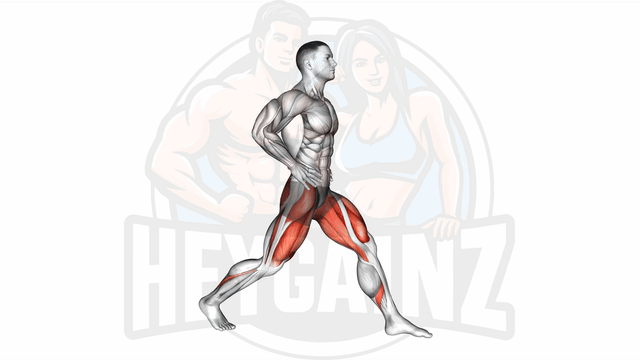
Instructions:
- 1Stand straight with your feet hip-width apart
- 2Step one foot forward and lower your body until your front knee is at a 90-degree angle
- 3Hold the position for a few seconds
- 4Push back up and repeat with the other leg
- 5Keep alternating between legs
Tips:
- Keep your body upright and your core engaged
- Try to keep your front knee directly above your ankle
- Push up with your heel not your toes
- Inhale as you lower your body, exhale as you push back up
All About the Static Lunge
The static lunge is a highly effective exercise targeting the hips and thighs, primarily focusing on the gluteus maximus and quadriceps. This bodyweight exercise not only builds strength but also enhances balance and stability, making it a valuable addition to any fitness routine.
Static Lunge Benefits
Incorporating static lunges into your workout can lead to numerous benefits:
- Strength Building: It effectively strengthens key muscle groups, aiding in overall lower body development.
- Improved Balance: The exercise promotes stability, which can translate to enhanced performance in various physical activities.
- Injury Prevention: Strengthening the muscles around the hips and knees helps reduce the risk of injuries.
How to Perform a Static Lunge
To execute the static lunge correctly:
- Start in a standing position, feet hip-width apart.
- Step one foot forward and lower your body until both knees are bent at about a 90-degree angle.
- Ensure your front knee stays aligned over your ankle and your back knee hovers just above the ground.
- Hold this position to maximize the effectiveness of the exercise.
Static Lunge Variations
For those looking to increase the intensity, static lunges with weights using dumbbells or other resistance can be added. This variation not only challenges your muscles further but also enhances overall strength development.
When comparing static lunge vs. split squat, both exercises primarily target the lower body, but the static lunge requires less movement, making it a suitable option for those seeking to focus on form and stability. On the other hand, the static lunge vs. reverse lunge offers different angles of muscle engagement, with the reverse lunge also focusing on glute activation but involving a backward stepping motion.
Proper Form and Safety Tips
Maintaining proper form during static lunges is crucial to prevent injury:
- Engage Your Core: Keep your core tight to stabilize your torso throughout the movement.
- Align Your Knees: Avoid letting your front knee extend beyond your toes during the lunge.
- Practice Breath Control: Inhale as you lower your body, and exhale as you hold the position.
In conclusion, the static lunge is a versatile and effective exercise suitable for individuals of all fitness levels. Whether performed as part of a comprehensive workout or as a standalone movement, this exercise can help achieve your fitness goals effectively. Incorporate it into your routine and reap the benefits of stronger hips and thighs!